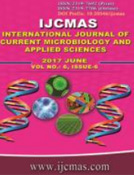


 National Academy of Agricultural Sciences (NAAS)
National Academy of Agricultural Sciences (NAAS)

|
PRINT ISSN : 2319-7692
Online ISSN : 2319-7706 Issues : 12 per year Publisher : Excellent Publishers Email : editorijcmas@gmail.com / submit@ijcmas.com Editor-in-chief: Dr.M.Prakash Index Copernicus ICV 2018: 95.39 NAAS RATING 2020: 5.38 |
Air quality in hospital working room has to be paid attention to because patients are prone to disease, in addition to avoid cross contamination. One of air pollution indicators in room is fungi. This study aimed to determine air quality based on fungal count in working rooms of “X” hospital and correlate it with air environment factor values (Total Suspended Particles/TSP, temperature, and humidity). Fungal sampling from the air was carried out using Midget Impinger containing 0.9% NaCl with three (3) replications, prior to planting in PDA media and colony counting using Colony Counter. The result indicated that the physical air quality relatively belonged to high category with the highest TSP 0.78 mg/m3 (RD) (50.35%), the highest temperature 28°C (RD) (22.31%), and the highest humidity 95% (RR). According to Decree of the Ministry of Health of the Republic of Indonesia No.1405/ MENKES/SK/XI/2002, fungal count in the working rooms met the standard<700 CFU/m3, meaning that there was no correlation between fungal count and temperature, humidity, and TSP. However, fungal exposure in the air of “X” hospital rooms is to be paid attention to, i.e. by keeping humidity maximum 45-60% and pay attention to people density in the working room.
Khusnul Khotimah and Dwi Nur Aini Dahlan. 2017. Analysis of Microbiological Air Quality Based on Fungal Count as Parameter in Working Rooms of “X” Hospital in Balikpapan.
Int.J.Curr.Microbiol.App.Sci. 6(5): 2220-2226. doi: https://doi.org/10.20546/ijcmas.2017.605.248 |
 |
 |
 |
 |